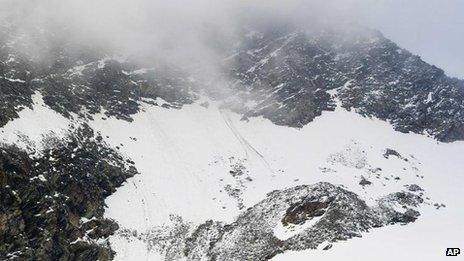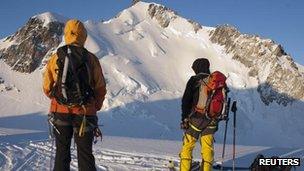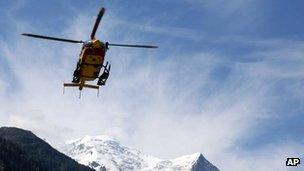Climbing death toll sparks debate on Alps tourism
- Published
- comments

The Lagginhorn claimed the lives of five German climbers in early July
It's been a tragic start to the climbing season in the Alps.
At the start of July, five German climbers were killed as they were beginning their descent of the Lagginhorn in southern Switzerland.
The sixth member of their group, who had paused just below the summit, had to watch as the other five, among them his 20-year-old son and his 14-year-old daughter, fell to their deaths.
Last week in Chamonix, nine climbers died in a sudden avalanche which injured 12 more. A total of 28 people were caught up in the snow slide.
No-one is suggesting that those climbers, who were highly experienced, and many of whom had climbed Mont Blanc before, were not well-equipped, or that they had ignored weather conditions.
But some mountaineers are asking whether the Alps are becoming simply too crowded. The route the climbers in Chamonix took last Thursday is often called "the highway to Mont Blanc", where queues sometimes form.
So although everyone who knows the Alps accepts that, even in summer, avalanches are a fact of life, many are asking whether an avalanche need to have caused so many casualties - should such a large group of climbers all have been in that spot at the same time?
Competition
What's more, the competition for places in mountain huts, where climbers spend the night before making their final ascent, is fierce. Reservations often have to be made well in advance.

An avalanche on Mont Maudit, near Chamonix, killed nine climbers this month
Someone who has planned his or her summer holiday around an ascent of Mont Blanc may not want to call the whole thing off because the weather looks a little bit less than perfect, especially when they know they won't get a place in a mountain hut for another year.
Just two days after the Chamonix tragedy, a further two climbers froze to death on Mont Blanc after being caught in a storm.
Slovenian mountain guide Klemen Gricar, who was in the group just following the one hit by Thursday's avalanche, told the Swiss newspaper NZZ am Sonntag: "We all know Mont Blanc is overcrowded."
In some places, he said, "a maximum of three people can traverse at one time. The rest have to wait. So queues build up. The waiting time can be half an hour, even 45 minutes, during which groups are waiting on an exposed mountainside".
Environmental damage
A few years ago, the mayor of St Gervais, the village from which the easiest and most popular route up Mont Blanc begins, called for a limit on the number of climbers on the mountain.
"It's just too free, everyone's coming to climb Mont Blanc," said Jean-Marc Peillex.
"It's supposed to be a protected area, but the mountain refuges are full, people are camping on the ice, it just can't go on like this."
His primary motivation was environmental. The thousands of climbers were leaving some very unpleasant rubbish behind them: empty bottles, discarded food containers, even, for those who had camped rather than stay in a mountain hut, their own excrement.
Each year the villagers organised a clean up, and several mountain train loads of rubbish were transported back down to the valley. It was time, many said, to introduce permits for climbing Mont Blanc, to charge an eco tax, and to limit numbers, along the lines of what already happens for Mount Everest.
But the idea wasn't popular. The entire Mont Blanc region lives off the mountains, the population relies on the income brought in by the 20,000 climbers a year who come to conquer Europe's highest mountain and spend a lot of money while they are doing it.
But now, in the wake of the avalanche, questions about numbers have arisen again.
'Not Disneyland'
The problem is no-one can come up with a workable solution.

Alpine rescue services regularly complain they have to deal with poorly prepared climbers
Short of reducing the beds available in mountain huts and banning camping, Bruno Hasler of the Swiss Alpine Club is not sure what can be done.
"I don't think charging fees would be legal, certainly not in Switzerland," he said. "And anyway all the climbers would be against it. But it's true, the more people you have, the more accidents there are."
Most climbers and guides hold firmly to the belief that the Alps, as part of Europe's natural environment, should be open to all.
"The Alps are not a ride in Disneyland," said one mountain guide. "They are here for all of us."
But acknowledging that the high mountains should remain freely accessible to all requires that those who go to the Alps don't treat them like Disneyland either. Respect for the environment and awareness of danger are essential.
Cable cars, mountain railways, and well-groomed trails have made some of the highest peaks reachable even for inexperienced hikers.
The alpine rescue services regularly complain bitterly that they have had to pluck people off the mountains who really had no business being up there.
On Switzerland's Matterhorn, in recent years, tourists have been rescued whose footwear turned out to be only gym shoes or flip-flops.
"There is a danger in what we call the herd mentality," said Mr Hasler. "One or two people alone might look around, and turn back, but when people see lots of other people up there, they think they are safe."
So although everyone accepts that last week's avalanche was well-nigh impossible to predict, and that the climbers involved had taken all necessary precautions, the debate is now raging again about how access to Europe's high mountains should be organised.
- Published13 July 2012
- Published14 July 2012
- Published3 July 2012